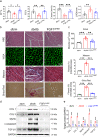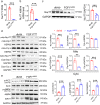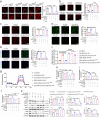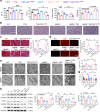FGF1ΔHBS prevents diabetic cardiomyopathy by maintaining mitochondrial homeostasis and reducing oxidative stress via AMPK/Nur77 suppression
- PMID: 33762571
- PMCID: PMC7991671
- DOI: 10.1038/s41392-021-00542-2
FGF1ΔHBS prevents diabetic cardiomyopathy by maintaining mitochondrial homeostasis and reducing oxidative stress via AMPK/Nur77 suppression
Abstract
As a classically known mitogen, fibroblast growth factor 1 (FGF1) has been found to exert other pleiotropic functions such as metabolic regulation and myocardial protection. Here, we show that serum levels of FGF1 were decreased and positively correlated with fraction shortening in diabetic cardiomyopathy (DCM) patients, indicating that FGF1 is a potential therapeutic target for DCM. We found that treatment with a FGF1 variant (FGF1∆HBS) with reduced proliferative potency prevented diabetes-induced cardiac injury and remodeling and restored cardiac function. RNA-Seq results obtained from the cardiac tissues of db/db mice showed significant increase in the expression levels of anti-oxidative genes and decrease of Nur77 by FGF1∆HBS treatment. Both in vivo and in vitro studies indicate that FGF1∆HBS exerted these beneficial effects by markedly reducing mitochondrial fragmentation, reactive oxygen species (ROS) generation and cytochrome c leakage and enhancing mitochondrial respiration rate and β-oxidation in a 5' AMP-activated protein kinase (AMPK)/Nur77-dependent manner, all of which were not observed in the AMPK null mice. The favorable metabolic activity and reduced proliferative properties of FGF1∆HBS testify to its promising potential for use in the treatment of DCM and other metabolic disorders.
Conflict of interest statement
The authors declare no competing interests.
Figures







Similar articles
-
FGF1ΔHBS ameliorates chronic kidney disease via PI3K/AKT mediated suppression of oxidative stress and inflammation.Cell Death Dis. 2019 Jun 12;10(6):464. doi: 10.1038/s41419-019-1696-9. Cell Death Dis. 2019. PMID: 31189876 Free PMC article.
-
Fibroblast growth factor-21 prevents diabetic cardiomyopathy via AMPK-mediated antioxidation and lipid-lowering effects in the heart.Cell Death Dis. 2018 Feb 14;9(2):227. doi: 10.1038/s41419-018-0307-5. Cell Death Dis. 2018. PMID: 29445083 Free PMC article.
-
A new FGF1 variant protects against adriamycin-induced cardiotoxicity via modulating p53 activity.Redox Biol. 2022 Feb;49:102219. doi: 10.1016/j.redox.2021.102219. Epub 2021 Dec 18. Redox Biol. 2022. PMID: 34990928 Free PMC article.
-
Signaling Pathways Related to Oxidative Stress in Diabetic Cardiomyopathy.Front Endocrinol (Lausanne). 2022 Jun 15;13:907757. doi: 10.3389/fendo.2022.907757. eCollection 2022. Front Endocrinol (Lausanne). 2022. PMID: 35784531 Free PMC article. Review.
-
FGF1 as a New Promising Therapeutic Target in Type 2 Diabetes: Advances in Research and Clinical Trials.Diabetes Metab Syndr Obes. 2025 Apr 16;18:1137-1149. doi: 10.2147/DMSO.S505285. eCollection 2025. Diabetes Metab Syndr Obes. 2025. PMID: 40260262 Free PMC article. Review.
Cited by
-
Obesity cardiomyopathy: evidence, mechanisms, and therapeutic implications.Physiol Rev. 2021 Oct 1;101(4):1745-1807. doi: 10.1152/physrev.00030.2020. Epub 2021 May 5. Physiol Rev. 2021. PMID: 33949876 Free PMC article. Review.
-
Resveratrol alleviates high glucose-induced oxidative stress and apoptosis in rat cardiac microvascular endothelial cell through AMPK/Sirt1 activation.Biochem Biophys Rep. 2023 Mar 1;34:101444. doi: 10.1016/j.bbrep.2023.101444. eCollection 2023 Jul. Biochem Biophys Rep. 2023. PMID: 36926277 Free PMC article.
-
Macrophage DCLK1 promotes obesity-induced cardiomyopathy via activating RIP2/TAK1 signaling pathway.Cell Death Dis. 2023 Jul 13;14(7):419. doi: 10.1038/s41419-023-05960-4. Cell Death Dis. 2023. PMID: 37443105 Free PMC article.
-
Mechanisms and therapeutic opportunities in metabolic aberrations of diabetic wounds: a narrative review.Cell Death Dis. 2025 Apr 25;16(1):341. doi: 10.1038/s41419-025-07583-3. Cell Death Dis. 2025. PMID: 40280905 Free PMC article. Review.
-
Heart failure with preserved ejection fraction (HFpEF) in type 2 diabetes mellitus: from pathophysiology to therapeutics.J Mol Cell Biol. 2022 Sep 12;14(5):mjac028. doi: 10.1093/jmcb/mjac028. J Mol Cell Biol. 2022. PMID: 35511596 Free PMC article. Review.
References
Publication types
MeSH terms
Substances
LinkOut - more resources
Full Text Sources
Other Literature Sources
Medical
Molecular Biology Databases
Research Materials
Miscellaneous

